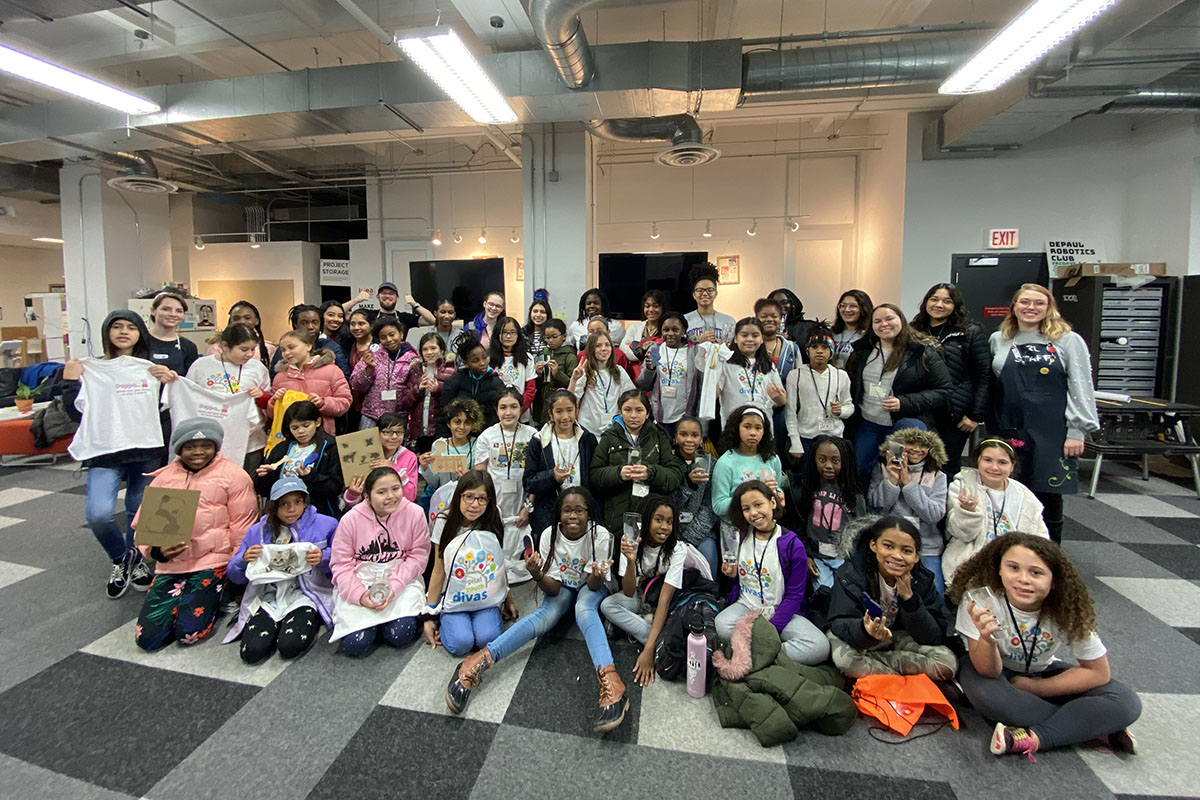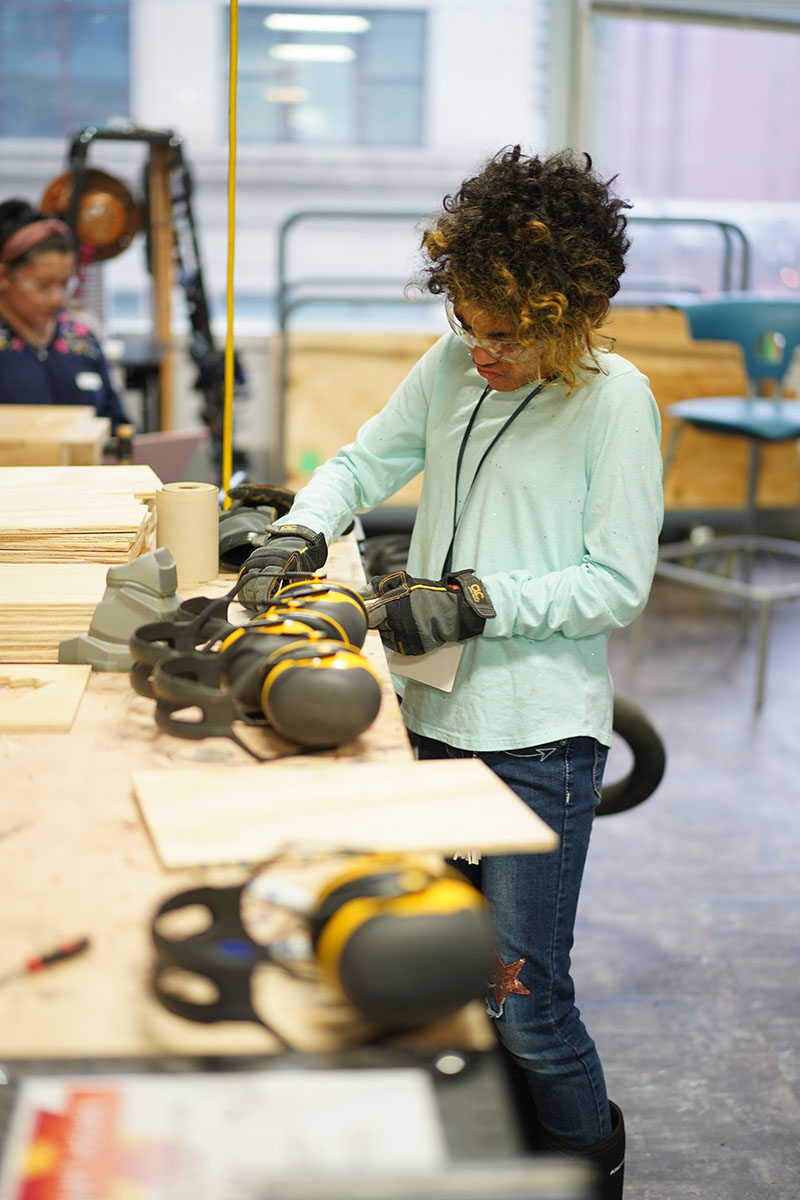 In January, members of Digital Youth Divas and the Caring Adults Network visited the Idea Realization Lab on DePaul's Loop Campus. (DePaul University/Stephanie Nikolas)
In January, members of Digital Youth Divas and the Caring Adults Network visited the Idea Realization Lab on DePaul's Loop Campus. (DePaul University/Stephanie Nikolas)
At first glance, Digital Youth Divas may look like other after-school programs. Middle-school girls meet weekly to work on STEM-based projects and activities, such as making bracelets with LED lights. But Digital Youth Divas goes far beyond project-based learning. The goal is to create a full “learning ecosystem” with mentors, parental resources and community support.
Approximately 500 girls have participated in the program since Digital Youth Divas launched in 2013. Recently, the National Science Foundation awarded coordinators another grant to sustain and grow the program, which is led by the College of Computing and Digital Media’s Sheena Erete and Denise Nacu, and Northwestern University’s Nichole Pinkard.
As a collaborative program spanning universities, Digital Youth Divas is an example of institutions coming together to address an urgent real-life issue. The program targets girls of color, because women of color continue to be underrepresented in STEM fields.
Digital Youth Divas has three components, or levels: students, families - the “Caring Adult Network,” and community organizations. About 45 students participate in the fourth- and fifth-grade program, while another 15 girls attend the sixth- to eighth-grade Divas Circle program. College-age mentors lead the sessions, which feature hands-on design projects and an online social network platform.
“There are a range of projects students work on that cut across different disciplines and engage them in learning technology, using design skills, working together and becoming part of a supportive cohort,” says Nacu, director of the School of Design at DePaul.
The online platform includes narrative stories that follow characters in a virtual Digital Youth Divas group who must overcome various challenges. Students work together to problem solve.
 Members of Digital Youth Divas participated in hands-on projects during a visit to DePaul’s Loop Campus IRL this winter. (DePaul University/Stephanie Nikolas)
Members of Digital Youth Divas participated in hands-on projects during a visit to DePaul’s Loop Campus IRL this winter. (DePaul University/Stephanie Nikolas)
“I’ve witnessed self-awareness and self-confidence soar as youth dive into their STEM identities,” says Miranda Standberry-Wallace, the program’s community relations and engagement manager. “The girls present their works proudly at Divas showcases, a train-the-trainer style event in which the girls teach their audience how and why their projects exist and the value placed on them.”
Parents and other caregivers in the audience develop their own networks thanks to workshops and resources designed specifically for them. In January, CDM hosted a tour and lunch for the Caring Adults Network.
These events help the Digital Youth Divas team learn more about the needs of caregivers.
“How can we engage parents to support their girls’ participation and what is needed?” Nacu explains.
Through the Technology for Social Good Lab, which Nacu and Erete co-direct, 10 CDM graduate and undergraduate students are assisting with these research questions.
“Students are developing really useful skills in designing technology, facilitating design workshops, creating and designing surveys, understanding interview protocols—all the ins and outs of qualitative research,” Nacu says.
Ivonne Garcia, a senior majoring in user experience design, is a research assistant in the lab. Thanks to this project, she has a better understanding of how her chosen field goes beyond the creation of digital technology.
“We’re focusing on designing physical experiences, systems and curriculum,” she says. “While I’m still designing a digital platform, I’m working with my users every step of the way to improve both my design and their experiences with out-of-school learning.”
Through the digital platform, parents can learn more about community organizations and opportunities to extend their child’s STEM engagement. These partnerships are critical in helping widen and deepen the learning ecosystem. Organizations such as the Evanston Public Library and MetaMedia at the McGaw YMCA complement the work of the Digital Youth Divas.
“One of the issues in our ecosystem design is creating these connections from one experience to another and thinking about pathways from middle school to high school and beyond,” Nacu says. “We’re interested in sustained engagement. Are students participating in after-school programming year-round? Are they participating in online activities that are offered?”
Over the next three years, Erete, Nacu and the team hope to better understand the connections between the youth, caregiver and community levels. They also hope to serve as a national example of best practices in working within a community to build support around STEM initiatives.
“We’re trying to develop a holistic model,” Nacu says. “It’s not just at school, it’s not just at home, it’s not just online. People develop their interests across multiple settings.”